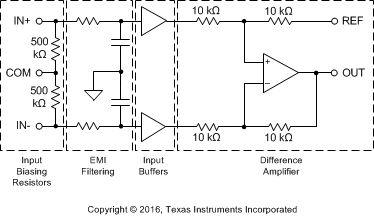JAJSDR4C August 2017 – May 2019 INA1650-Q1 , INA1651-Q1
PRODUCTION DATA.
7.3.1 Audio Signal Path
Figure 39 highlights the basic elements present in the audio signal pathway of the INA165x-Q1 line receivers. The primary elements are input biasing resistors, electromagnetic interference (EMI) filtering, input buffers, and a difference amplifier. The primary role of an audio line receiver is to convert a differential input signal into a single-ended output signal while rejecting noise that is common to both inputs (common-mode noise). The difference amplifier (which consists of an op amp and four matched 10-kΩ resistors) accomplishes this task. The basic transfer function of the circuit is shown in Equation 1:

 Figure 39. INA165x-Q1 Audio Signal Path (Single Channel Shown)
Figure 39. INA165x-Q1 Audio Signal Path (Single Channel Shown) The input buffers prevent external resistances (such as those from the PCB, connectors, or cables) from ruining the precise matching of the internal 10-kΩ resistors that degrade the high common-mode rejection of the difference amplifier. As is typical of many amplifiers, a small bias current flows into or out of the buffer amplifier inputs. This current must flow to a common potential for the buffer to function properly. The input biasing resistors provide an internal pathway for this current to the COM pin. The COM pin connects to ground in a dual-supply system, or to the output of the internal supply divider, VMID(OUT), in single-supply applications. Finally, EMI filtering is added to the input buffers to prevent high-frequency interference signals from propagating through the audio signal pathway.